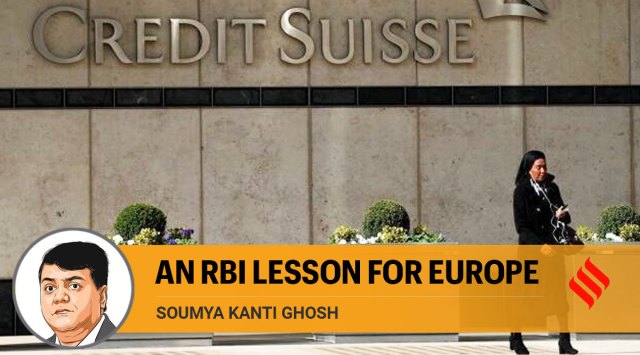
On Monday, across the world, markets opened with a bit of nervousness, even as the takeover of the crisis-ridden Credit Suisse received the blessing of the local regulator and policymakers. While the acquirer, the Union Bank of Switzerland, has the full might of the Swiss National Bank behind it, it is anyone’s guess whether the merged entity will emerge as a poster child of a failed confidence-building measure or not. The reverberations of this deal, once it passes muster in jurisdictions outside Switzerland, will likely be felt for a long time.
The demise of the 167-year-old bank —once a darling of markets in revered niche areas of wealth management and investment banking but one that had been haemorrhaging post the global financial crisis of 2008 — could also mark the beginning of a new era. It could bring to the fore major issues facing European banks that are battling lacklustre home markets and failed bets in mainland China, along with stiff competition from US banking behemoths.
The wipeout of the entire portfolio of contingent convertible/AT1 bonds (used for bolstering the bank’s capital) worth $17 billion will erode confidence for new issuers, and raise the risk premia disproportionately in this $250 billion bond market.
The CDS (credit default swap) of Credit Suisse, already approaching alarming high levels in recent days for protection against near-term default, may result in rating changes for financial markets and even sovereigns. Moreover, the demands for payment from diverse protection buyers can be daunting for UBS, SNB and the entire banking system wanting safe harbour in the storm.
Lost in this kerfuffle is also the issue of leadership. In 2020, Tidjane Thiam, the then CEO of Credit Suisse, stepped down from the troubled Swiss bank, giving in to pressure from select quarters despite an impeccable record in bringing the beleaguered lender back on track.
The series of events over the past few weeks seem to cast a shadow over the credibility of these central banks, their ability to provide regulatory forbearance, steer markets through turmoil and ensure well-orchestrated, coordinated monetary and fiscal policies.
It is a bit disappointing that major central banks have done precious little to assuage market fears on a ticking time bomb — the maze of huge mark-to-market losses accruing in the books of banks during a regime of rapidly rising yields. Barely a week after giving Credit Suisse a 50 billion Swiss francs lifeline, the hurried blessing to the merger only shows that regulators need to plan their moves with clarity, in consultation with broader market participants to continue to remain in the driving seat.
Against this background, it needs to be pointed out that the Reserve Bank of India and the government have worked in unison ever since the pandemic began to steer the economy. The playbook adopted by the RBI in times of crises, deployed at a systemic level and led by large and systemically important banks, has been the best-integrated policy response both in 2008 and 2020.
In fact, short-term borrowing by the First Republic Bank — $30 billion from 11 different US banks — for a very short period of 90 days, appears short-sighted if we compare it to similar packages in India in 2008 and 2020 by the RBI when a consortium of banks hand-held ailing banks for multi-year periods.
It would seem that both central banks and governments around the world can learn a trick or two from India in terms of coordinating monetary and fiscal policy responses during the pandemic. Ironically, fiscal policy dominance — a lexicon often used to describe India’s policy mistakes in the past — has now come to haunt Western economies. On a lighter note, economists seldom point out that the US had a brush with activist fiscal policies even in the 1960s when John F Kennedy’s economic council had four Nobel laureates to advise on policy.
Coming back to government policies, the upward revision in the deposit insurance limit by the Indian government in 2020 needs to be seen in comparison to the US. For example, as per independent research estimates, smaller bank deposits in the US are insured in the range of 30-45 per cent only. In contrast, smaller bank deposits in India such as regional rural banks, cooperative banks and local area banks are better protected at 82.9 per cent, 66.5 per cent, and 76.4 per cent respectively, while public sector banks, which have a large proportion of customers from rural, urban and semi-urban areas have better customer deposits protection in comparison to private banks.
Further, India’s deposit insurance coverage to per capita income ratio at 2.53 is one of the highest across the world. Brazil, which has the highest insurance coverage ratio, has a far more expansive definition, which raises questions of serviceability if any contagion reaches its shores.
Indian banks are also in sound financial health. Moreover, when compared to other major countries, India has the least foreign claims, both on counterparty basis, and on a guarantor basis. Additionally, our ratio of foreign claims to domestic claims is also the least among countries signalling that our banking and financial system is very disciplined, and that no fear that an international balance sheet contagion can originate from here.
It needs to be pointed out that banks in emerging economies are now on track for more robust performance on the back of a robust regulatory framework, greater policy initiatives, framed in coordination by both regulators and governments.
The writer is Group Chief Economic Advisor, State Bank of India. Views are personal